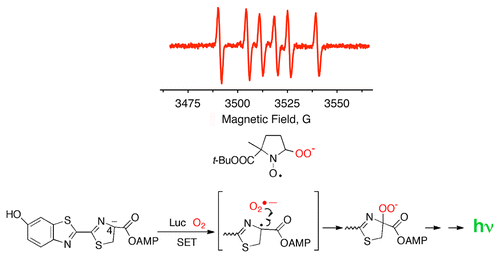However, at presen,t the population of fireflies is decreasing and increasingly difficult to find due to light pollution at night and damage to most firefly habitats.
Light of fireflies themselves is often referred to as cold light by scientists because the light of fireflies does not produce side heat. Unlike light bulbs, almost 100% of the energy used by fireflies is converted into visible light that is yellow, green, or orange with a wavelength between 510 and 670 nm.
These rays are utilized by fireflies, among others, to communicate with each other, attract partners, to be used to warn when threatened by predators.
Notice how the luciferase is on both sides of the equation? That’s because it’s a catalyst—it speeds up the reaction, but is not used up by the process. AMP (adenosine monophosphate) is what ATP becomes after it is used for energy. The oxyluciferin has an asterisk (*), meaning it has an electron in the excited state, and this is the key to why fireflies glow. Fireflies source
Do you know, behind the beautiful rays of insects from the Lampyridae family are hidden mechanisms of chemical reactions that have not been completely solved by scientists? The chemical reaction is called bioluminescence.
Basically, bioluminescence in fireflies uses a chemical called luciferin and the enzyme luciferase which is contained in the cells in the abdomen of fireflies.
The light reaction takes place in two steps: (1) luciferin + ATP → luciferyl adenylate + PPi; (2) luciferyl adenylate + O2 → oxyluciferin + AMP + light. Exploration of luciferase-based light reactions source
Luciferin will react with adenosine triphosphate (ATP) to form luciferyl adenylate and pyrophosphate (PPi) on the surface of the luciferase enzyme.
Luciferin + ATP → luciferil adenylate + PPi
Then, luciferyl adenylate will react with oxygen to produce oxyluciferin, adenosine monophosphate (AMP), and energy in the form of light that can be seen as a colourful light of fireflies.
Luciferyl adenylate + O2 → oxyluciferin + AMP + light
However, in the mechanism of the reaction above, scientists found that luciferin and oxygen cannot react easily. This remains a mystery for 60 years until finally in 2015 Connecticut College researcher Bruce Branchini and his team managed to uncover the mystery.
Apparently, the oxygen used in the bioluminescence process is not ordinary oxygen but is in the form of superoxide anion (oxygen with excess electrons).
“The way enzymes and proteins can convert chemical energy into light is a very basic phenomenon,” They knew it started with a chemical called luciferin, which interacts with the energy-transporting molecule adenosine triphosphate, or ATP. The product of that reaction then combines with oxygen and, in turn, releases light. Branchini’s group wanted to know more about the exact steps, so they explored potential mechanisms in the lab. They experimented with the enzyme luciferase, which boosts the initial reaction between luciferin and ATP, under varying conditions. In contrast to the commonly accepted model, the resulting data suggest that the transfer of a single electron to oxygen occurs during one of the final steps to spur light production. Branchini's mechanistic results may represent a unifying feature of the highly diverse natural phenomenon. Branchini’s group wanted source
By understanding the mechanism of bioluminescence, we can more easily project the application of bioluminescence in various fields such as medicine and energy.
For example, light from the chemical luciferin can be used to detect tumour and cancer cells or maybe later glow in the dark trees can be created that can replace street lights at night.
Reference:
Exploration of luciferase-based light reactions source
Branchini’s group wanted source



Congratulations @sward! You have received a personal award!
Click on the badge to view your Board of Honor.
Downvoting a post can decrease pending rewards and make it less visible. Common reasons:
Submit
Thank you
Downvoting a post can decrease pending rewards and make it less visible. Common reasons:
Submit